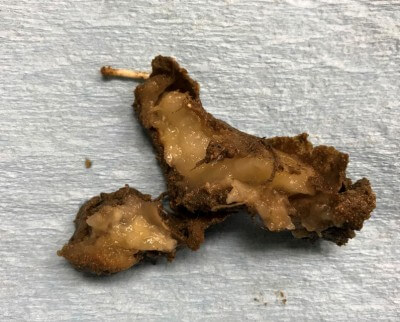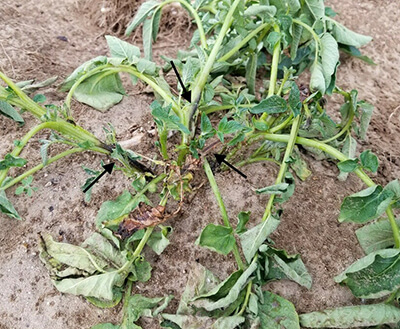 Aerial stem rot, blackleg and tuber soft rot of potato have been found in fields in Michigan. Tuber soft rot results in rotting tissue that is mushy, slimy and water-soaked. Soft rot of the potato seed piece can occur following planting and results in poor emergence or create foliar symptoms such as weak plants with curled and drooping leaves that often resemble wilt disease or water deficiency.
Aerial stem rot, blackleg and tuber soft rot of potato have been found in fields in Michigan. Tuber soft rot results in rotting tissue that is mushy, slimy and water-soaked. Soft rot of the potato seed piece can occur following planting and results in poor emergence or create foliar symptoms such as weak plants with curled and drooping leaves that often resemble wilt disease or water deficiency.
Aerial stem rot symptoms appear as black lesions that are produced on infected stems. Blackleg symptoms appear as black lesions at the base of the stem and can quickly girdle the stem as they expand upward. Unlike tuber soft rot, infected plant stems have a black appearance.
These diseases were not a major issue in the U.S. until the 2015 growing season. In 2015, infected seed and a wet June were contributing factors in a high incidence of aerial stem rot in parts of Michigan.
Blackleg, aerial stem rot and tuber soft rot are caused by either the bacteria Dickeya spp. or Pectobacterium spp. Identification by DNA analysis is under way by Michigan State University’s Potato and Sugarbeet Pathology Lab to identify those species of bacteria from the submitted samples. The confirmed infected variety of potato was Reba.
 The first step in effective disease management of potato is accurate pathogen identification and diagnosis. Visually, Dickeya and Pectobacterium cause similar symptoms. Culture and DNA-based detection methods are now available to distinguish between these two pathogens.
The first step in effective disease management of potato is accurate pathogen identification and diagnosis. Visually, Dickeya and Pectobacterium cause similar symptoms. Culture and DNA-based detection methods are now available to distinguish between these two pathogens.
Because of similarities between the pathogens and symptoms, growers should send a sample of a plant with a suspected pathogen to a diagnostics lab, such as MSU Diagnostic Services, for accurate identification to determine effective management actions.
For more information on disease symptoms, the disease cycle and post-harvest management strategies, growers can refer to this MSU Extension bulletin.
Source: Michigan State University Extension